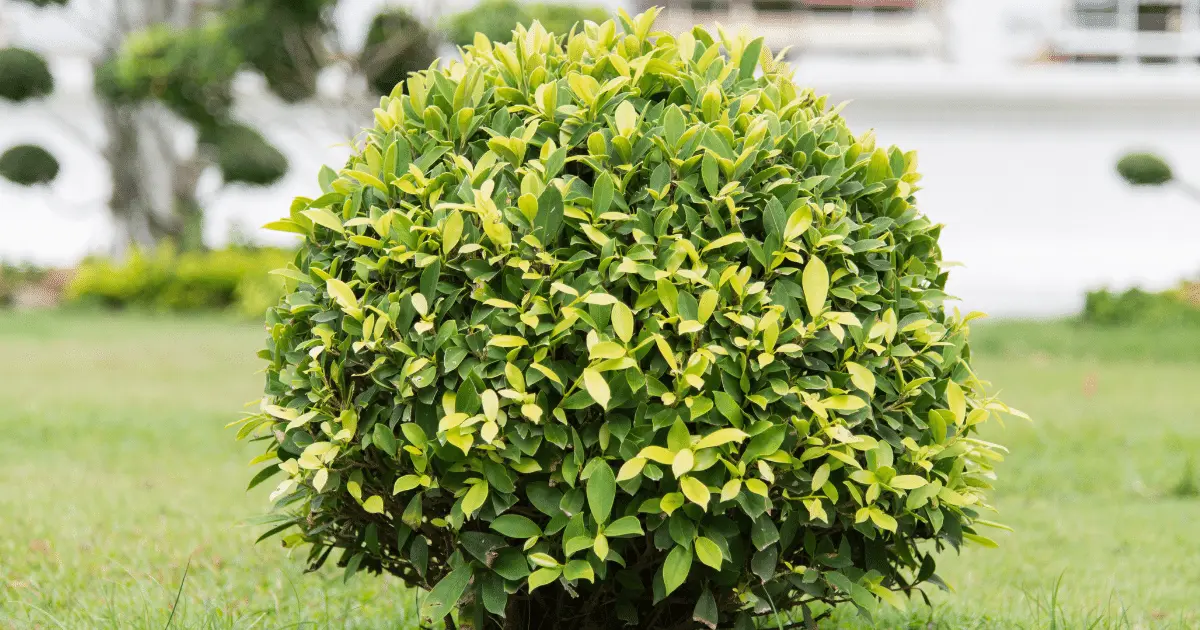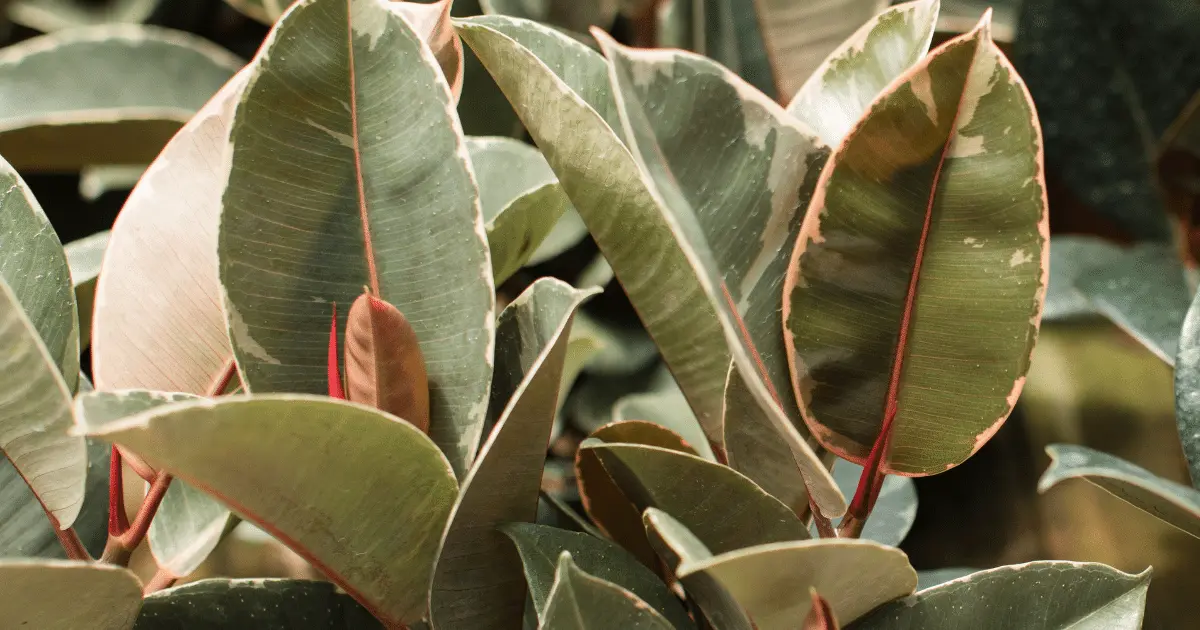Variegated rubber plants combine green and yellow leaves, like a living art form full of subtle visual appeal. It grows in bright, indirect sunlight and makes an excellent low-maintenance plant. They are unique plants with many exciting features and characteristics that make them the perfect complement to any home or office environment.
The rubber plant (Ficus Elastica) has long been popular as an indoor houseplant, and it’s easy to see why! This beautiful tree grows to about 8–10 feet tall outdoors, but it can be kept much shorter in a pot indoors. The rubber plant produces glossy leaves with yellow striping that set off its unique white flowers.
This article will go through detailed steps on growing and caring for variegated rubber plants.
What is a Variegated Rubber Plant?
The variegated rubber plant, Ficus elastica’ Variegata’, also known as the snake plant, is an indoor plant that has leaves with white or yellow stripes. The leaves are dark green on the top, while on the bottom, they are paler; variegation can vary from one leaf to the next. This plant needs bright light but not direct sunlight, and it can tolerate dry soil in moderate conditions but prefers moist soil.
In the United States, rubber plants are one of the most popular indoor plants, and they can be grown indoors year-round and are relatively easy to maintain. The easiest way to grow a rubber tree is by propagating cuttings in water or soil. A few leaves will occasionally drop from the plant, but this is normal.
The Basics of Variegated Rubber Plant

Rubber plants with variegated leaves require very little light and humidity to thrive, which makes them relatively easy to take care of. You can grow them in pots of well-draining soil or plant them in any garden bed with rich, moist soil. The plant should be watered regularly, but keep the potting soil dry between watering.
The variegated rubber plant should be fertilized once every two months during spring and summer, with an organic fertilizer diluted by half its recommended strength. For example, if you were using 10-10-10 as your brand of fertilizer, use 5-5-5.
However, if you’re growing your variegated rubber plant indoors, it may need more frequent fertilization. Hence, check on the leaves periodically to determine whether it needs a dose of compost tea or liquid fish emulsion; both will provide adequate nutrients without harming the delicate foliage.
Types of Variegated Rubber Plants
Originally from Southeast Asia’s tropical rainforests, variegated rubber plants grow in various colors. They grow best in humid environments with bright, indirect light and come in wide varieties. Moreover, after blooming, these plants die after their first bloom. Hence, removing all flowers as they appear will help to prevent the plant from self-pollinating, which could cause problems later on.
1. Robusta Sativa
Robusta is a sturdy ficus elastica cultivar with huge leathery green leaves. It can endure low humidity inside and grow to 4-6 feet.
2. Ficus elastica “Decora”
This cultivar is slightly different from “Robusta” because it has broader and bigger dark-green leaves. The leaf’s middle vein is crimson below and somewhat white on top, and the casing around the young leaves is similarly a rich crimson color.
3. Yellow Gem

The Yellow Gem cultivar, also known as ‘Ficus altissima,’ is a robust and striking rubber plant with green-centered, leathery leaves with a golden-green color at the edges. It grows quickly and looks excellent in huge pots.
4. Burgundy
The botanical name for this type of rubber plant is ‘Ficus elastica.’ ‘Burgundy,’ as the name implies, has rich, deep burgundy to practically black leaves on red stems. For the unique leaf color, give it plenty of humidity and intense light.
5. Ruby Red

The Red Ruby is yet another distinct variation of the rubber plant known as ‘Belize.’ This attractive species has big dark green leaves richly variegated with red, white, and purple colors. The fresh leaves emerge in a beautiful pink-red hue.
Points to Consider Before Growing Variegated Rubber Plant
Before growing a variegated rubber plant, there are specific points you must consider if you want the best possible results. These points are as follows:
1. Location, Soil, and Watering Needs
Variegated rubber plants need bright but indirect sunlight. Hence, picking a location with an abundance of bright sunlight is crucial. They will grow best in soil mixed with sand or perlite. When watering, make sure the plant is not sitting in water. Finally, be mindful of the temperature, as variegated rubber plants do not thrive in extreme heat or cold.
2. Fertilizing Needs
Fertilizer is needed to grow healthy plants. The best fertilizer is liquid plant food, which you can purchase at your local garden center. For every gallon of water, add one tablespoon of liquid plant food.
Always check the directions on the back of the package before adding any fertilizer because they will tell you how much to use per gallon or quart (1 liter). After fertilizing, wait about 30 minutes before watering again to allow the fertilizer to work through the soil and roots.
3. Propagating Your Variegated Rubber Plant
Variegated rubber plants grow best when they are potted in moist soil that has been mixed with peat moss. They also prefer cooler temperatures, so try to place them away from windows that get direct sunlight.
In addition, your plants will need plenty of water during their growing season, so ensure that the soil remains moist. However, you want the potting mix to stay smooth since too much water can cause root rot.
4. Pests and Diseases to Watch Out For
Some pests commonly infest variegated rubber plants: spider mites, scale insects, aphids, whiteflies, mealybugs, thrips, and nematodes. These pests will cause the plant’s leaves to turn yellow or brown as they suck the life out of it.
Variegated rubber plants can also get diseases like leaf spots, powdery mildew, and viruses. If you find any signs of these problems on your variegated rubber plant, take care of them quickly. A regular dose of insecticidal soap or spray will usually do the trick.
Growing Variegated Rubber Plant
There are two ways to grow and propagate a rubber plant: stem cutting and air layering.
STEM CUTTING
Step 1: Gather your materials, including a chopstick, a sealable plastic bag, a sharp knife, and rooting hormone (optional).
Step 2: Using a sharp knife, cut about 6 inches above the leaf node of a healthy branch. There should be at least one leaf on the top of each stem cutting, and the tips must cluster two to three leaves at the tip.
Step 3: Remove any lower leaves and inject the rooting hormone into the cutting’s root. Then plant the root in a tiny pot containing moistened all-purpose potting soil.
Step 4: Seal the plastic bag with the cutting. Use the chopstick to keep the bag from touching the leaves. Close the bag almost entirely (but not totally) to keep moisture in.
Step 5: Place the bag in a spot with warm, indirect light. Carefully remove the plastic bag once the roots have developed within 2-3 months, and check for fresh foliage after six months.
AIR LAYERING
Step 1: Gather your materials, including a toothpick, a transparent plastic bag, sharp gardening scissors, twines, long-fibered sphagnum moss, and rooting hormone (optional).
Step 2: Select a healthy region of the plant to propagate. Pick a good position at least 6 inches underneath the leaves on the stem for air layering before trimming the leafy tops.
Step 3: Carefully make an upward vertical cut approximately one-third of the way along the stem with a sharp, clean blade.
Step 4: Push the toothpick inside the cut sideways to keep it open. Add the rooting hormone to the cut area to accelerate the process. However, you don’t need to use the rooting hormone since new roots will develop without it.
Step 5: Soak a handful of sphagnum moss and wrap it with a rope around the stem cut. This provides a medium for the new roots to grow.
Step 6: To keep moisture in, wrap the plastic around the stem slightly above and below the cutting, covering the moss ball.
Step 7: After a few months, remove the protective wrap and clip the stem slightly below the newly developing root. Fill a container with clean soil and plant the rubber tree. Maintain moist but not damp soil. Your rubber tree will be able to tolerate more water when the stem begins experiencing new growth.
Caring for Variegated Rubber Plant
The variegated rubber plant requires very little maintenance, just a little attention here and there. If grown in a container, change the potting mix when necessary and if outdoors, be sure to repot as often as necessary so that there is no compacted soil underneath the root system.
To ensure your variegated rubber tree remains in healthy condition, it’s essential to follow a few simple guidelines, such as:
- Keep an eye on the soil moisture level of your rubber tree. It should always be wet, but too much or too little water might cause problems.
- In addition to checking soil moisture, keep your plant in a compact pot that can’t contain enough water to drown it, even if you’re heavy-handed with the watering can.
- When you see dust building on the sparkling leaves of your rubber tree, gently clean them off with a soft brush or a moist cloth. You can also give your plant a moderate rinse in the shower to cleanse the foliage.
- Avoid direct sunlight
- Protect it from drafts
- Place it away from window screens.
Variegated rubber plants are beautiful, easy-to-care-for plants that are perfect as houseplants. They require little light or water and can be grown in pots or hanging baskets. With proper care, they will grow up to two feet tall. It is important to remember to water them sparingly since they can’t tolerate too much water.
